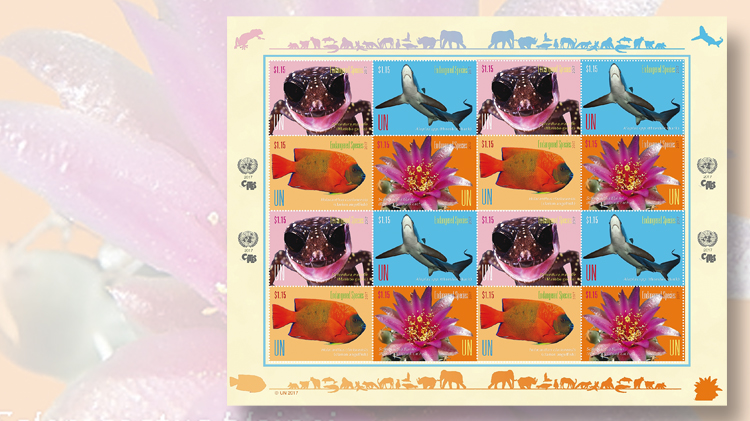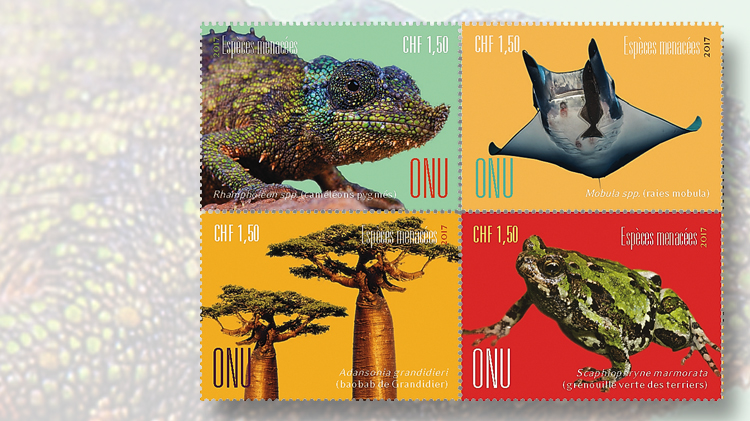World Stamps
United Nations continues long-running Endangered Species series
By Denise McCarty
The United Nations Postal Administration will issue 12 stamps in its Endangered Species series May 11. The series began in 1993.
The new set is a joint issue with Romania, which is expected to issue four stamps. According to information from the UNPA, these stamps will show endangered species that are native to Romania.
The U.N. stamps picture species that were recently added or updated in appendices to the Convention on International Trade in Endangered Species of Wild Fauna and Flora as a result of the COP17 World Wildlife Conference held in Johannesburg, South Africa, Sept. 24-Oct. 5, 2016.
Connect with Linn’s Stamp News:
Sign up for our newsletter
Like us on Facebook
Follow us on Twitter
An international treaty, CITES aims to ensure that international trade in specimens of wild animals and plants does not threaten their survival.
The U.N. stamps will be issued in panes of 16, each with four se-tenant (side-by-side) designs. There is a separate pane for each U.N. post office.
The four $1.15 stamps for use from the post office at U.N. headquarters in New York City feature the Masobe gecko (Paroedura masobe), a nocturnal reptile endemic to the island of Madagascar; the thresher shark (Alopias spp.), which uses its long, whiplike tail to stun its prey; the clarion angelfish (Holacanthus clarionensis); and Blaine’s fishhook cactus (Sclerocactus blainei).
The latter two species are native to North America. The clarion angelfish is found in the Pacific Ocean off the coast of Mexico. Small populations of Blaine’s fishhook cactus, also called Blaine’s pincushion, are found in Nevada and Utah.
The four 1.50-franc stamps for use from the post office at the Palais des Nations in Geneva, Switzerland, also depict three animals and one plant.
The plant is Grandidier’s baobab (Adansonia grandidieri), one of nine species of baobab trees.
Believed to be pollinated by nocturnal lemurs, this giant tree is endemic to Madagascar, where it grows up to 98 feet tall and 9 feet wide.
According to National Geographic, “Ninety percent of the plants and animals found on the island of Madagascar evolved there and nowhere else.”
Another example pictured on a 1.50fr Endangered Species stamp is the green burrowing or marbled rain frog (Scaphiophryne marmorata), found in rain forests on the eastern part of Madagascar. As its name suggests, this frog likes to burrow, especially in dead leaves on ground.
The other two 1.50fr stamps show the pygmy or African leaf chameleon (Rhampholeon spp.), and the devil ray (Mobula spp.).
This tiny chamelon are endemic to eastern Africa and recently have been exported for the pet trade.
The devil ray is named for its fins that resemble horns. It also is known as the lesser ray because it is smaller than the manta ray.
The only mammal in this Endangered Species set is the Caucasian tur (Capra caucasica) featured on an €0.80 stamp for use from the post office at the Vienna International Center in Vienna, Austria. This wild goat is endemic to the Caucasus Mountains in Azerbaijan, Georgia, and the Russian Federation, according to CITES.
Illustrated on the other €0.80 stamps are a nautilus (Nautilidae spp.), Natal or wild ginger (Siphonochilus aethiopicus), and a William’s dwarf gecko (Lygodactylus williamsi).
The National Oceanic and Atmospheric Administration Fisheries and the U.S. Fish and Wildlife Service’s proposal to include the chambered nautilus on the CITES’ list said: “Chambered nautiluses are marine invertebrates which are prized for their distinctive chambered shells. As cephalopods, the Family Nautilidae is related to squids and octopuses but differs by having external shells, lengthy maturation and producing few young. There are two main genera of chambered nautiluses and seven species.”
Natal ginger grows wild in several African countries, but it is threatened because of its popularity in herbal medicines.
Also known as the turquoise or the electric blue gecko, William’s dwarf gecko is endemic to only a few forests in eastern Tanzania.
Because of collection for the pet trade and habitat destruction, this gecko is considered to be critically endangered.
Rorie Katz of the United Nations designed the stamps, using photographs from Nature Picture Library and Almay Stock Photo.
Joh. Enschede of the Netherlands printed the stamps by offset lithography in the following quantities: 16,000 panes of the $1.15; 17,000 panes of the 1.50fr; and 19,000 panes of the €0.80.
Each stamp measures 39.2 millimeters by 28.6mm and is perforated gauge 12½ by 12¾.
The selvage of the panes includes a border design of silhouettes of different endangered species. A similar border design was used in the Endangered Species series through the 2014 set, but did not appear in the selvage of the 2015 and 2016 issues.
Shown in the four corners of each pane is one of the species featured on the stamps.
Pictured on both sides of each pane is the U.N. emblem with the year date “2017” and “CITES” below it.
For ordering information for the Endangered Species stamps, visit the website; email unpanyinquiries@un.org; telephone 800-234-8672; fax 212-963-9854; or write to UNPA, Box 5900, Grand Central Station, New York, NY 10163-5900.
MORE RELATED ARTICLES
Headlines
-
US Stamps
Oct 7, 2024, 3 PMMcMurtrie dismissed as APS education director following Sept. 21 arrest
-
US Stamps
Oct 7, 2024, 12 PMVasiliauskas named president of Mystic Stamp Co.
-
US Stamps
Oct 6, 2024, 5 PMApgar souvenir card available
-
US Stamps
Oct 6, 2024, 4 PMFirst Continental Congress and U.N. stamps receive Scott catalog numbers










